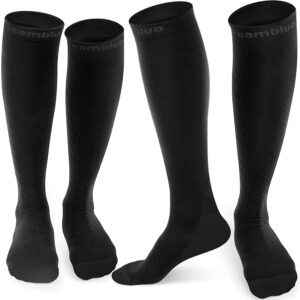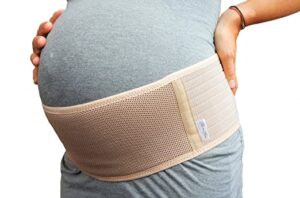Varicose veins are swollen and enlarged veins that usually occur on the legs and feet.
Symptoms:
-
Swollen and enlarged veins that are blue or dark purple in colour, often lumpy, bulging or twisted in appearance.
-
Aching, heavy and uncomfortable legs.
-
Swollen feet and ankles.
-
Burning or throbbing in your legs.
-
Cramps in the legs are also associated with varicose veins, which are usually worse at night (see section on cramps).
-
The skin might be dry, itchy and thin.
-
Symptoms may be worse with prolonged standing.
Causes:
-
being overweight
-
having a job that involves long periods of standing
-
Heredity.
-
Increased blood volume.
-
Change in hormones.
-
Increased pressure from the uterus and growing baby (on blood flow).
Here is what the evidence says about the treatment options:
Compression Stockings – THIS study found that women using compression stocking during pregnancy were up to three times less likely to develop varicose veins. We looked at stockings online and THESE have really good reviews. Always speak to your GP / midwife regarding varicose veins before using any intervention.
Maintain a good weight – Keep weight within the recommended range for your stage of pregnancy to help reduce pressure on blood flow. Have a read of our ‘weight management‘ section for some more tips.
Maternity support belts – It is theorised that maternity belts can help to support the back and hips and reduce pressure from the growing bump on the legs and pelvis. This is thought to improve circulation, blood flow and therefore reduce leg oedema, helping to relieve pressure on the veins. There are no high quality studies (that we know of) that can prove this theory but maternity belts are seen as safe additions to your pregnancy aids.
There are also currently no studies to show which support belts work best or for how long you should be wearing them. We have put together our top 5 choices (here) to help guide you based on what they can help with and what we like about them.
Exercise – Movement is key in preventing varicose veins. Stay active in any way that feels right for you. Here are two types of exercise that we really love and are generally safe for everyone no matter what stage of pregnancy they are in.
Have a look at our Top 5 online pre and postnatal Pilates programmes here.
There are also lots of Online Yoga programmes available, have a look at our Top 5 here (and why we love them)! You can also read our blog on how yoga can help in other ways.

Reflexology – Reflexology appears to help improve symptoms for women with leg oedema, but again this is based on one small study (43 women) that was found.
Rutosides – Rutosides appear to help relieve the symptoms of varicose veins in late pregnancy. However, this finding is based on one small study (69 women) and there are not enough data presented in the study to assess its safety in pregnancy. It therefore cannot be routinely recommended.
What symptoms to watch for:
DVT (deep vein thrombosis) is a blood clot in a vein, usually the leg. DVT can be dangerous. Get medical help as soon as possible if you think you have DVT. The symptoms you might experience with a DVT are:
-
throbbing or cramping pain in 1 leg, (usually in the calf or thigh).
-
swelling in the affected leg.
-
warm skin around the painful area.
-
red or darkened skin around the painful area.
-
swollen veins that are hard or sore when you touch them.



